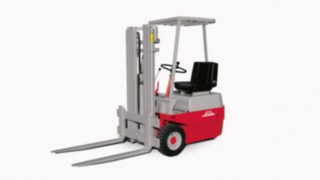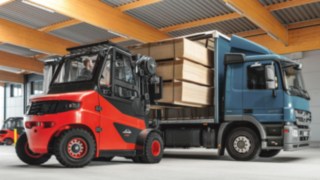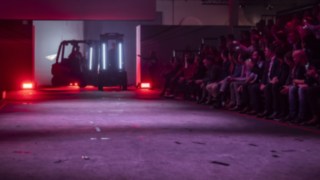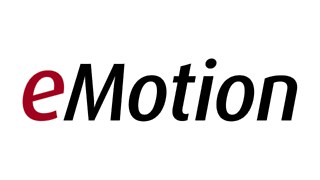A look back at 50 years of electric forklift trucks
Niche Product Turns Climate Savior
Today, the electric drive is viewed as a beacon of hope for climate protection. However, this wasn’t always the case. When Linde Material Handling unveiled the first electric forklift truck in 1971, the technology was considered to be very niche. However, even then, the signs were pointing towards environmental protection.
Sometimes history presents us with astonishing coincidences; events that, at the time, seem entirely unrelated, but in hindsight seem almost prophetically intertwined. One such coincidence occurred in 1971, and is referred to by historians as the birth of German environmental awareness.
In September, Willy Brandt’s social liberalist government adopted Germany’s first political environmental program, while almost simultaneously one of the oldest German environmental initiatives was emerging in the Upper Rhine region. At that time, environmental protection primarily meant repairing the damage caused by industrial air and water pollution. Modern considerations relating to climate protection by means of emission-free transport were still a long way off.
The requirements for intralogistics are completely different from those of the road and even back then it was clear that dirty, noisy internal combustion engines were no longer suitable for such operations.
While the whole country was talking about nature conservation and ecology for the first time, something was happening outside of the public eye that would subsequently contribute to the environmental debate in ways that no one at the time could even imagine. At the Hanover Fair in 1971, Linde Material Handling presented its first battery-powered forklift truck, the E10 – E15. What seemed like an inconspicuous product launch at the time actually laid the foundations for the widespread industrial application of a technology without which climate protection in intralogistics would be impossible today.

Modest beginnings, constant improvement
Only a few years earlier, hardly anyone would have predicted that Linde would go electric in the early 1970s. At that time, the technology had been eking out a sad and sorrowful niche existence for decades. Still the dominant technology for truck engines in around 1900, political and social developments had temporarily put an end to the promise of e-mobility.
At the start of the 20th century, the emerging oil lobby flooded the market with cheap gas. The combustion engine quickly became the production standard for motorists, with its roaring, smoking engine elevated to a status symbol. For Dutch technology historian, Gijs Mom, it was primarily these cultural factors that prevented the spread of early e-cars.
The coming decades cemented the idea that there were no alternatives to combustion engines. This concept became so firmly rooted in people’s minds that not even the oil crisis of the 1970s helped the e-drive to make a comeback. So, why did Linde engineers return to a technology that was shunned by car makers and had hardly evolved for decades?
“The requirements for intralogistics are completely different from those of the road,” explained Stefan Prokosch, Senior Vice President Brand Management at Linde Material Handling. “Thanks to a boom in logistics, the forklift truck made its way into warehouses at the end of the 1960s, giving rise to a need for quiet, emission-free trucks. Even then, the dirty, noisy internal combustion engines were no longer suitable for such operations.”
A Battery with a Screwed-on Seat
Prokosch still remembers well the arduous beginnings of the electric forklift truck, “Our specialty at Linde was and still is the hydrostatic drive, which uses the power of the combustion engine for the truck’s lifting movement. That meant our combustion engines were significantly more powerful for many years. We had to build up our competence in electrics bit by bit.”
According to Prokosch, the first electric forklift trucks were just “a battery with a screwed-on seat”. Nevertheless, they sold well right from the start. By the time the second E10 – E15 series was launched, Linde was already delivering 70,000 trucks. With the new E-version, the forklift truck manufacturers from Aschaffenburg have hit a nerve.
We aimed to further develop the E-drive so as to make the combustion engine technically obsolete.

With the E20 – E30, Linde introduces two pioneering innovations at once: The new combi-steering axle and tilting cab.

With the E20 – E30, Linde introduces two pioneering innovations at once: The new combi-steering axle and tilting cab.
Fueled by a flourishing mail order trade and the emergence of early e-commerce platforms, the logistics industry will experience unprecedented growth in the coming years. Space in warehouses is becoming scarce and expensive. In the narrow aisles of brimming warehouses, Linde’s electric forklift trucks show off their full technical class: The unique interplay between the combi-steering axle, twin-motor front-wheel drive and dual-pedal control makes them particularly maneuverable and productive.
Prokosch recalls, “Even back then, the electric forklift trucks could turn 180 degrees around their own axis, which represented an enormous efficiency gain when maneuvering in tight spaces. Later, in 1994, it was also possible to transfer this principle to four-wheeled electric forklift trucks.”
The Gap Closes
Over the years, Linde perfected its electric forklift trucks for indoor use. However, one crucial shortcoming remained: For all their agility and energy efficiency, the trucks could not match the sheer lifting power of the classic combustion engine. “For a long time, capacity above 5 metric tons was a limit that played no role in the volume segment for electric forklift trucks,” explains Prokosch, “but we were determined that one day we would be able to close this gap.”

Linde engineers worked tirelessly to make the electric forklift truck into a powerhouse. Then finally, we hit a milestone. In 2015, the models E60 – E80 hit the market. Thanks to improved power electronics, a more powerful engine and more high performance battery, these were the first electric Linde trucks that could lift weights of up to eight metric tons.
This massive forklift turnaround was also clearly noticeable to our customers and, for the first time, in 2016, they ordered more electric trucks from Linde than internal combustion engines. Prokosch recalled, “We aimed to further develop the E-drive so as to make the combustion engine technically obsolete. The figures show that we are edging closer to this goal with each new series.”

The X20 – X35 has passed the critical test by forklift expert Theo Egberts.

The X20 – X35 has passed the critical test by forklift expert Theo Egberts.
Linde will take the final decisive step in 2021. In the middle of the year, theX20 – X35 models will be launched, and their performance and robustness will finally close the remaining performance gap to the combustion engine. “Linde has built a truck that is as fast and powerful as a diesel forklift,” remarked specialist journalist and renowned forklift truck expertTheo Egberts in a test report.
According to Prokosch, only one thing remains to be done. The company is currently working on an electric heavy truck capable of lifting up to 18 metric tons and, once that is achieved, it will be possible to use electric forklift trucks for every conceivable task. So, anyone wanting to do away with combustion engines for climate protection can do so without restrictions.
All just a coincidence?
The first time it seemed like pure coincidence. When Linde unveiled its first electric forklift truck in 1971, politicians and the public were just coming round to the idea of environmental protection. Fifty years later, the nations of the world are sitting around a table in the fight against climate change and jointly seeking ways to avert the greatest environmental catastrophe in history.
In 2021, at the climate conference in Glasgow, the UN states finalized the regulation for implementing the Paris Climate Agreement. The same year in which Linde may well have brought an end to the age of the combustion engine with its X-series electric forklift trucks. Another coincidence?

